
ABOVE: LEFT: Sir Stanley Spencer. RIGHT: Dougie Chowns. Do you notice in the photo, the signs of a dedicated artist?
I am definitely looking more and more like
SIR STANLEY SPENCER
I have been wanting to introduce you to Sir Stanley Palmer, but I don’t know why. Maybe because this photograph of him shows a tell tale sign of a painter that I identified with when at Art School just a few miles away, and now I am his senior. Hence us both. The paint on his arm where he wiped his brushes is typical of our work and passion. How many shirts and even Sunday best suits did I ruin the same way.
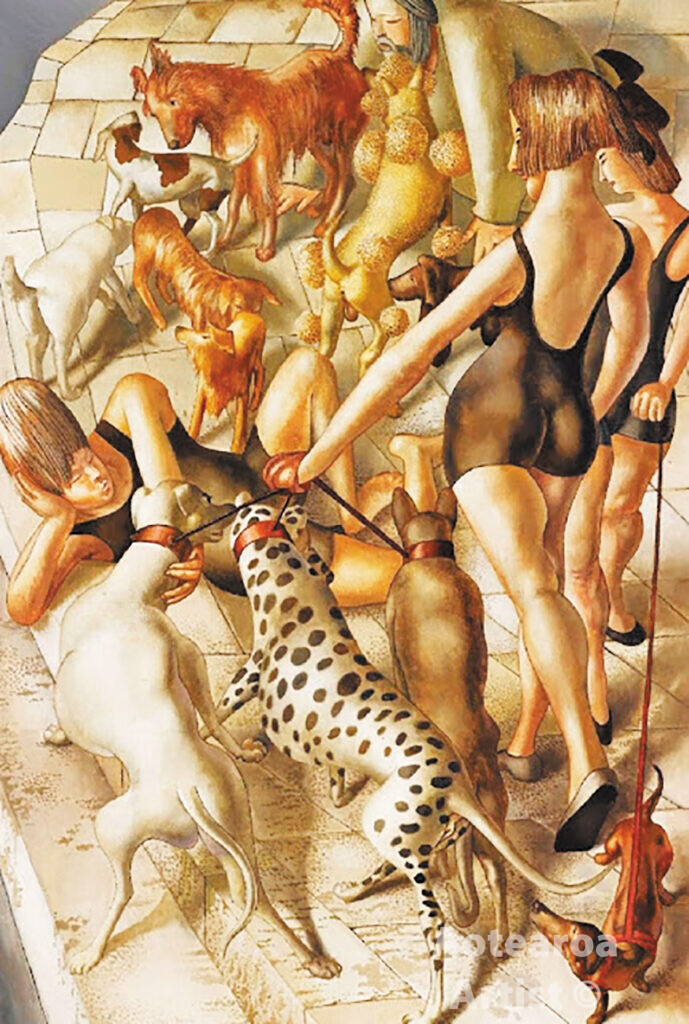
Born in 1891 a couple of years before my father, Stanley Spencer was a very consistent British Thames Valley artist with an eccentric personality. He was well established before my own birth and experienced both World Wars. After attending Art School daily in London, he served in Macedonia in 1914 with the Royal Army Medical Corps which coloured his thinking as well as his village resurrection subjects. London was an hour’s train ride following the Thames from his old-world Thames-side village of Cookham, where his father taught music. Schooled at home by his sisters, Stanley later studied at the Slade School of Art in Charing Cross Road London, with fellow student Paul Nash, to name but one of many other later notable British names of the day. He lived out his life in this pretty Thames side village which supplied much of his subject matter. Other than frequent visits to London, Cookham was his world, uniquely often featuring religious concepts using locals as his models to illustrate his scenes. Who but Stanley would show the village Church graveyard erupting with upended gravestones as souls emerged from below, on their way to heaven? He said he fell asleep among the graves on one occasion.
Stanley saw sexuality as ‘the graphic of obvious love’ I believe. A precious special emotion, an act of bonding, not merely between male and female but also between nations, races or simply people. This solitary graphic Cookham thinker, unspoiled by the ways of man and the world, in an open and honest way – incredibly so, shows us, I suspect, his idea of compatible life between not just humans, but between everything that breathes, grows, walks, smells and is worthy of mutual affection and love. Bees and flowers, The Thames and a summers day, a spinney of Alder trees. His Dogs, and dogs are exactly this, they have open minds free from inhibitions – they greet each other with a sniff – you know where, they openly sexually embarrass the narrow minded, or amuse. If re-incarnated, Stanley is back here as a dog – he would like that – and no doubt do and be the same as in his painting.
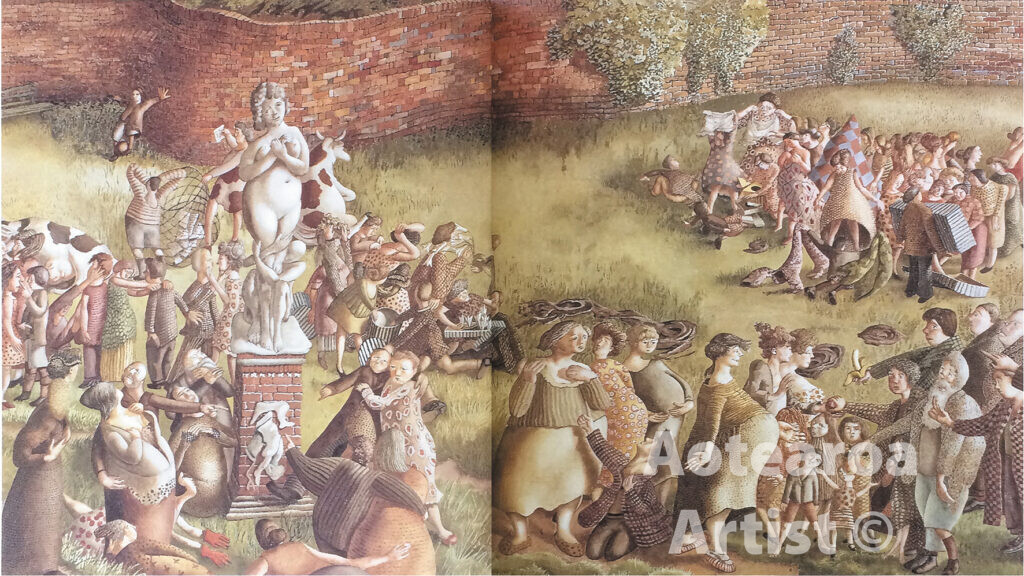
Recognized as an exceptional draughtsman by his tutors at the Slade, his virtuoso skill as a figurative artist and his unique creativity to combine biblical accounts with a Berkshire village is quite a fascinating idea, well, to me personally. Christ preaching while swan upping on moored skiffs in the Thames below the bridge or his painfully executed 1928 Resurrection of soldier’s chapel in Sandham Burghclere and much later the amusing ‘Love on the moor’ in which village secret passions are blatantly obvious. His sense of the naughty and ridiculous is quite amazing for his day and as a rather naive man who drew daily at the Slade School Life Class, believing in the Christian concept of sincere love between nations, later caused Sir Alfred Muninngs, former President of the Royal Academy, to accuse Stanley of ‘obscene’ paintings to the Police. We come into this world naked, so he often included himself naked – not that he was not sexually aware – what does he give away? Or is it rather more in the mind of the beholder, as is often the case. I notice him insignificantly wiping his brushes on his arm while painting, and a Daschund having an interesting sniff at the passing spotty Dalmation in his ‘Bathing Pool Dogs’. Stanley noticed these normal happenings, what dogs do, just a life’s detail, and so included them without reservation.
In 1937, the year I was born, only 25 miles away, he was painting his villagers in a large work ‘Love on the green’, again in amazing detail. The red brick wall – obviously deeply etched in his childhood psyche – is perhaps unlocking a deeply submerged graphic, maybe a similar reason Sir Winston Churchill had a thing about building brick walls? As a child I remember trying to climb similar home county church walls embedded with large sharp flints inches wide. I can still feel my knees cut and grazed, leaving lasting painful memories. As painters we give much away about ourselves in our work if one bothers to look for it, as Stanley certainly did.
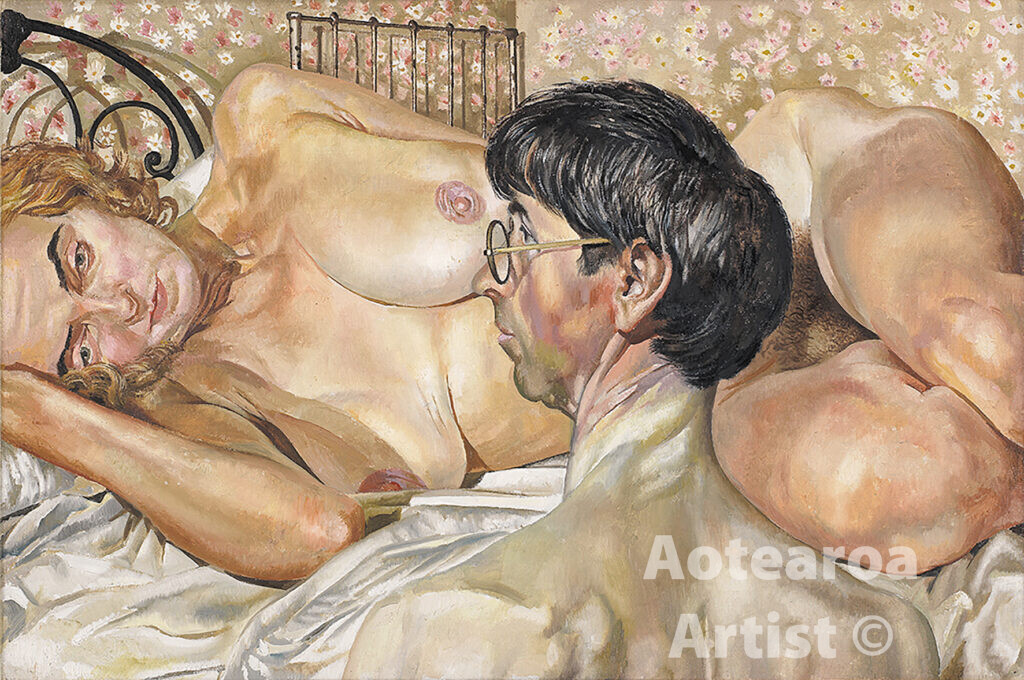
He immortalized his wife Hilda after her death to cancer in ‘Love on the Moor’ painting as a statue of the Goddess of love, himself perhaps depicted as the figure clinging to her legs. He was a man of longing and deep passion. He abandoned that work in 1937 but finished it eight years later after the war and a period as war Artist in the Glasgow Shipyards. He loved to capture unusual angles in his drawing and would be seen, to the amazement of the Clyde tradesmen, on top of a crane engine house or in a boiler with the welders. A sensitive soul returning to Cookham I believe Stanley suffered consequently in middle life at the hands of Ms Preece, a smart local woman, but as was unusual in those days and unknown even to him, a lesbian. Sexuality was not talked about, and the existence of these poor souls totally unknown. My mother had no idea about that sort of thing, the times were so different to today and these preferences were deep and damaging secrets indeed.
Poor Stanley – his paintings say it all. Totally overt and honest, he naively – years ahead of his day – graphically painted the astounding statement as he saw his relationship, having married Patricia who spent ‘his’ honeymoon with ‘her lover’ in preference to him. The wishful, inoffensive, small, well-spoken middle aged and sexually aware painter left impotent, with a ‘Leg of Mutton’. His model had him cruelly dangling on the end of a line. Is it a case of Pygmalion having gone wrong? Or a brave painting by a bewildered and confused man? Whatever, Patricia ‘burned’ him, seduced his home and savings and the poor, (but financially well off) music professor’s son let it happen – because he was a good soul.
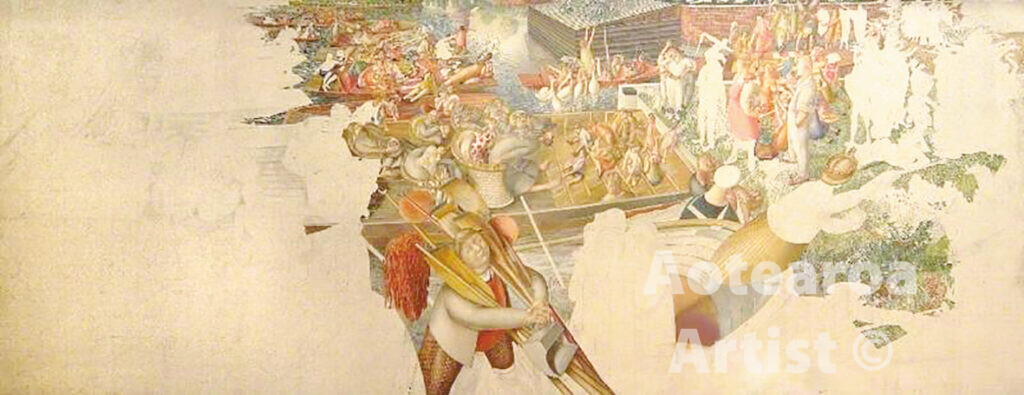
In 1953, when I was at Art School, had I also grown up in Cookham I suspect I would have found him fascinating. I would dearly have loved to know my own Bushey artists, Henry Justice Ford, Canadian Emily Carr or Ben Nicholson’s father Sir William Nicholson, who was sacked by Herkomer for posing the model with an open umbrella – I don’t know if she was nude! The Colonna Venus had a wine amphora, why not an umbrella?
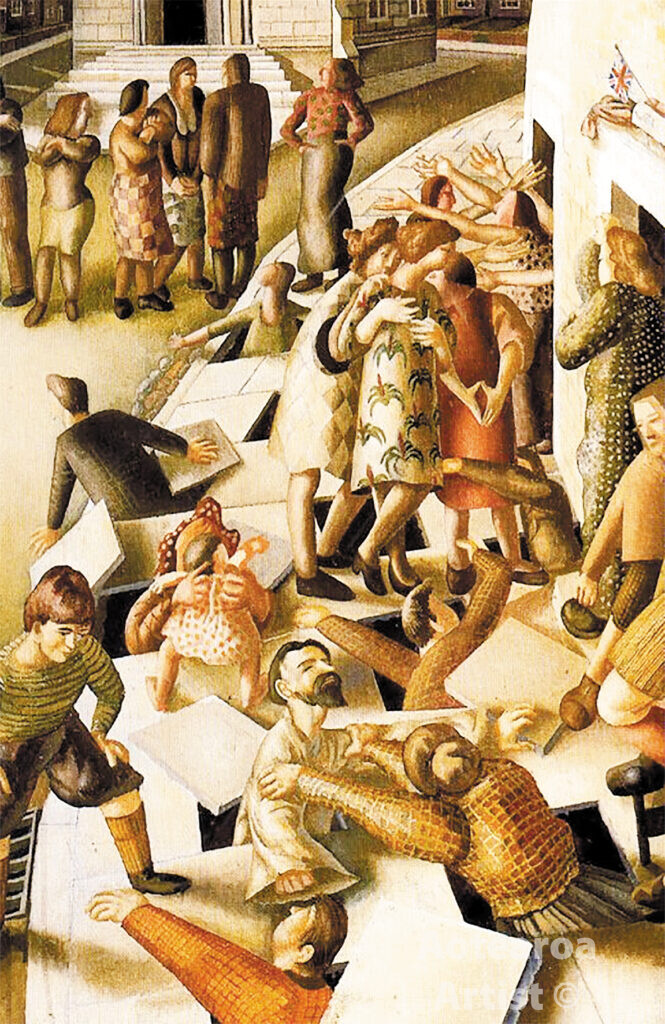
Stanley’s working style often borders on cartoons, similar at the same time to well-known Osbert Lancaster, also popular post-war. This serious but playful style – not seen today – was popular in 1951 when the Festival of Britain presented Barbara Hepworth, Jacob Epstein, the Comet first jet airliner, British Nylon and Plastics. It also featured ‘the Mousetrap’ that ran for decades, and film making that stepped away with astoundingly new techniques with ‘Tom Jones’ and writer John Osborne. All of this was quite special to the UK and was the creativity that launched Britain into Europe, heralding the highly creative sixties. Dear Beryl Cooke of our own time made hilarious paintings on the ‘steamy side’. My colleague Ted Lucie-Smith, Poet and art writer, olive wreathed, naked and very white, writing poems on the grass – ha ha! I think he has it in his flat. In a Cromwell tavern he saw the locals, a tiny man standing on a sideways bar stool playing the fruit machine and local bowls club in whites, hats and green blazers – if I send Beryl to NZ he said “you must bring her here” – Stanley would have equally loved that pub lounge.
The village of Cookham had hardly changed in 1996 when I took a glass blowing student and his wife on exchange, studying at Hampton Court one sunny weekend, while I was back with a One-Man Show. We walked the moor; the High Street and I videoed the tiny museum. It has always worried me that Stanley carefully drew the entire painting before starting to paint, then with no staining of the canvas, painted direct on white gesso often starting at the bottom right-hand corner, then towards the top, often leaving parts to be filled in on the way. That so famous and accomplished an artist would do this was to me like motorboat cruising on the Thames with ones fenders hanging over the side, or worse, when under sail with the inboard engine running and obvious shakes rippling in the luff. Just not done – old chap!
But so, what? And what of the humour? This man saw his villagers and village wonderfully. ‘Vicar of Dibley’ stuff, Stanley Spencer’s head, his often-cheeky mind, a religious Christian eye and a superb hand allowed him, for all time, to record his village and its times, as he saw it.
Thank you, Stanley – you have left us insight into your world – I feel I like and know these Thames Valley residents – other than that Ms Preece – that is!
Happy figurative painting friends, less empty landscapes please – smile and go for it! And don’t wipe your brushes on your arm.


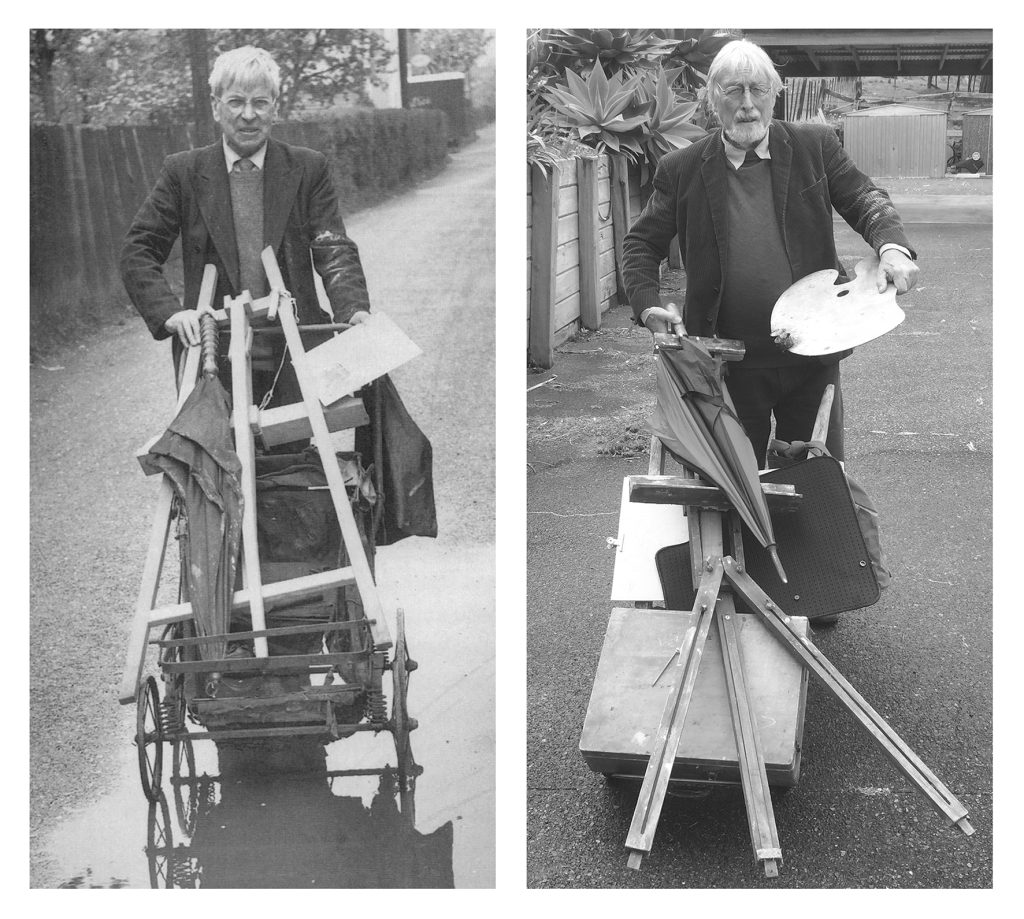
Comments (0)